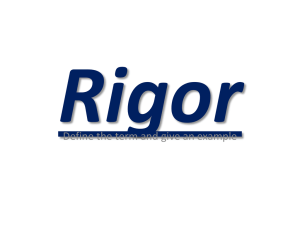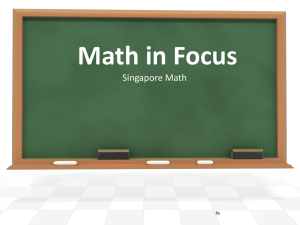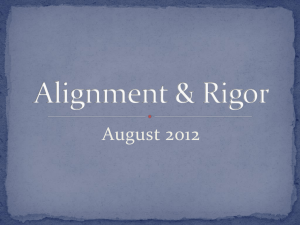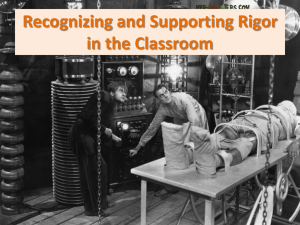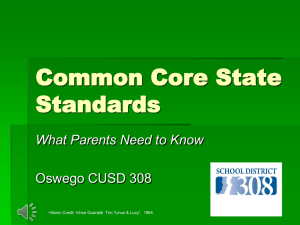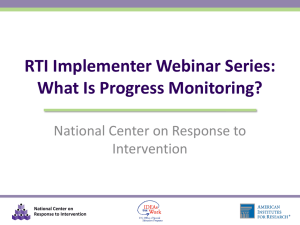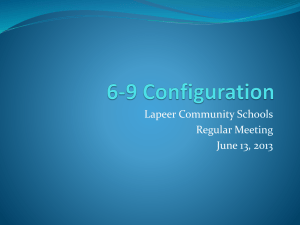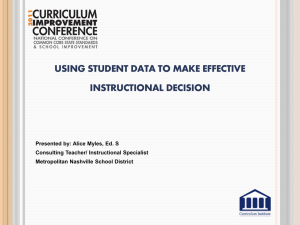REACH PT Librarian PD 6.16.14
advertisement
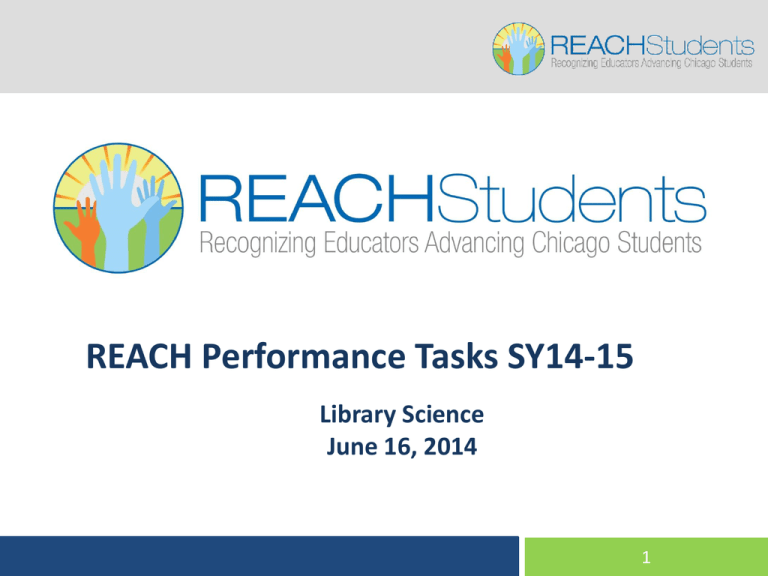
REACH Performance Tasks SY14-15 Library Science June 16, 2014 1 Agenda Introductions Part I : REACH Performance Task Overview Part II : Performance Task Components Part III: SY 14-15 2 Agenda Introductions Part I : REACH Performance Task Overview Part II : Performance Task Components Part III: SY 14-15 3 Performance Tasks as a Part of REACH Students REACH Performance Tasks are one of two student growth measures used in teacher evaluation. 4 Objectives For teachers, by teachers Measure of Student Growth Aligned to curriculum REACH Performance Task Objectives Communicate expectations Opportunity for collaboration Build assessment creation skills Instructional Tool Provide data on student performance 5 CPS Vision – Five Pillars 6 Overview Definition: Performance Task A written or hands-on demonstration of mastery, or progress towards mastery, of a particular skill or standard. Beginning of year and end of year administration measures student mastery over the course of an academic year on a set of identified knowledge, skills, or understanding. Why performance tasks? • • • Narrow but in-depth Reflect long-term, key outcomes Require higher-level and extended thinking 77 Administration Administration Guidelines of REACH Performance Tasks Time to Complete Designed to be completed in one class period. Task Assignment All students sharing a common subject/grade level/classroom receive the same task with the same directions. Proctoring Protocol Scoring Protocol Teachers proctor own class and collect tasks at the end. Teachers score the tasks of their students, in teacher teams if possible. 88 REACH PT Program Scope Approximately 125 task sets (BOY & EOY) across 12 different content areas, grades PK – 12 250 CPS teachers participate in task-writing 30 content specialists support task-writers Over 275,000 students completed Performance Tasks across CPS in SY 13-14 • ~5,500 students completed Library Science PTs 9 Agenda Introductions Part I : REACH Performance Task Overview Part II : Performance Task Components Part III: SY 14-15 10 Part II Agenda - Performance Task Components Step 1 – Identify Standards and Desired Student Outcomes Step 2 – Create the Performance Task Step 3 – Create the Scoring Rubric 11 Step 1a: Familiarize yourself with the standard Content leads selected standard(s) using three criteria Measurable within REACH Performance Tasks Foundational to the course or grade level Highly likely to be part of scope and sequence of instruction 12 Step 1b: Identify the skill(s)/content to be assessed from the standard 1. Identify the skill(s)/content assessed in the standard. 2. Identify the stretch level of measurable skill(s)/content 3. Phrase skill(s)/content as measurable objectives for the performance task CCSS.ELA-Literacy.RH.6-8.9: Analyze the relationship between a primary and secondary source on the same topic. What is the stretch level of skill(s)/content? Foundational Advanced Types of sources Analysis of an individual source Comparison and analysis of two or more sources on the same subject 13 Step 1b: Identify the skill(s)/content to be assessed from the standard Each objective identified will guide development of the task and rubric. These will be referred to as task objectives during rubric design. Scoring Rubric Task Objectives Insufficient Response Below Mastery Emerging Mastery Mastery Student distinguishes between types of sources 0 Points ? Points ? Points ? Points 0 Points ? Points ? Points ? Points Student analyzes an individual source concerning a specific topic Student compares and analyzes the relationship between two or more sources about the same subject Summative Score Standards CCSS.ELA-Literacy.RH.6-8.9 Analyze the relationship between a primary and secondary source on the same topic. 0 Insufficient Response ?-? Points 1 Below Mastery ?-? Points 2 Emerging Mastery ?-? Points 3 Mastery ?-? Points 14 Part II Agenda - Performance Task Components Step 1 – Identify Standards and Desired Student Outcomes Step 2 – Create the Performance Task Step 3 – Create the Scoring Rubric 15 Principles of Swagg 16 Step 2a: Create the Task Activity Design Principles Relevance Key Considerations • Incorporates materials and activities that are authentic to instruction and student experience in a given discipline Rigor • Maintains high cognitive demand throughout the task Stretch • Includes items that address foundational and advanced skills/content within the standard Alignment • Measures identified objectives (skills/content) that are aligned with the standard(s) Accessibility • Incorporates text and/or activities that all students can engage with, or that can be easily adapted for diverse learners 17 Step 2a: Task Design Principle: Relevance Relevance to: Key Considerations • Choice reflects course instruction Task Type Teachers Materials Activity Students Age Appropriate • Text-based: Students must respond to or analyze text or data • Action-based: Students physically demonstrate understanding • Hybrid: Includes both text and activity • Brainstorm content resources that ALL teachers have access to • Activity given in engaging context • Students apply situation or challenge to a relatable audience • Utilizes vocabulary and content appropriate for students’ level of understanding 18 Step 2a: Create the Task Activity Design Principles Relevance Key Considerations • Incorporates materials and activities that are authentic to instruction and student experience in a given discipline Rigor • Maintains high cognitive demand throughout the task Stretch • Includes items that address foundational and advanced skills/content within the standard Alignment • Measures identified objectives (skills/content) that are aligned with the standard(s) Accessibility • Incorporates text and/or activities that all students can engage with, or that can be easily adapted for diverse learners 19 Step 2a: Task Design Principle: Rigor RIGOR What is it? Refers to the complexity of cognitive demand and/or skill demonstration. Why incorporate higher levels of rigor? • Encourages higher-order thinking • More in-depth assessment of student learning How do you incorporate higher levels of rigor? Use Webb’s Depth of Knowledge (DOK) Framework to craft task activity. • • • Similar to Bloom’s Taxonomy 4 levels measure increasing complexity Concise approach to measuring the level of cognitive demand of a task, question, assignment, etc. 20 Step 2a: Task Design Principle: Rigor Depth of Knowledge (DOK) Framework Level 1 Recall requires simple remembrance or identification of such information as a fact, definition, term, or simple procedure. Level 2 Skill/Concept involves some mental skills, concepts, or processing beyond a habitual response; students must make some decisions about how to approach a problem or activity. Level 3 Strategic Thinking requires reasoning, planning, using evidence, and thinking at a higher level. Level 4 Extended Thinking requires complex reasoning, planning, developing, and thinking, most likely over an extended time. Cognitive demands are high, and students are required to make connections both within and among subject domains. http://www.wcer.wisc.edu/news/coverStories/aligning_alternate_assessments.php 21 Step 2a: Create the Task Activity Design Principles Relevance Key Considerations • Incorporates materials and activities that are authentic to instruction and student experience in a given discipline Rigor • Maintains high cognitive demand throughout the task Stretch • Includes items that address foundational and advanced skills/content within the standard Alignment • Measures identified objectives (skills/content) that are aligned with the standard(s) Accessibility • Incorporates text and/or activities that all students can engage with, or that can be easily adapted for diverse learners 23 Step 2a: Task Design Principle: Rigor vs. Stretch Stretch in REACH Performance Tasks The task activity should measure varying levels of skill/content within a standard. 1. Provides a more precise baseline measure 2. More effectively captures student growth STRETCH (Skill/Content Levels) Foundational Advanced 24 Step 2a: Task Design Principle: Rigor vs. Stretch Stretch in REACH Performance Tasks The task activity should measure varying levels of skill/content within a standard. 1. Provides a more precise baseline measure 2. More effectively captures student growth STRETCH (Skill/Content Levels) Foundational Advanced 25 Step 2a: Create the Task Activity Design Principles Relevance Key Considerations • Incorporates materials and activities that are authentic to instruction and student experience in a given discipline Rigor • Maintains high cognitive demand throughout the task Stretch • Includes items that address foundational and advanced skills/content within the standard Alignment • Measures identified objectives (skills/content) that are aligned with the standard(s) Accessibility • Incorporates text and/or activities that all students can engage with, or that can be easily adapted for diverse learners 26 Step 2a: Create the Task Activity Design Principles Relevance Key Considerations • Incorporates materials and activities that are authentic to instruction and student experience in a given discipline Rigor • Maintains high cognitive demand throughout the task Stretch • Includes items that address foundational and advanced skills/content within the standard Alignment • Measures identified objectives (skills/content) that are aligned with the standard(s) Accessibility • Incorporates text and/or activities that all students can engage with, or that can be easily adapted for diverse learners 27 Step 2a: Task Design Principle: Accessibility Accessibility Text-Based Tasks Action-Based Tasks Key Considerations • • • • • Select shorter text (10-15 minutes max to read) Define complex or unfamiliar vocabulary within text Avoid cultural, class and linguistic bias Age and grade level appropriate Provide embedded text supports (pictures, headings, etc) • Design activity so that all student can engage • Add accommodations, if necessary, for physical challenges • Incorporate varying means of task delivery and demonstration of mastery 28 Agenda Introductions Part I : REACH Performance Task Overview Part II : Performance Task Components Part III: SY 14-15 29 REACH Performance Tasks SY 14-15 ALL CPS teachers must administer a BOY and EOY Performance Task to one of their classrooms in SY 14-15 SY 14-15 BOY window: Sept. 15 - Oct. 17 • Beginning of year (BOY) tasks provide a baseline measure of student proficiency ‐ Teachers can target areas of improvement for their students based on their analysis of student work SY 14-15 EOY window: May 11 – June 12 • End of year (EOY) tasks capture whether or not students “grew” along the assessed standard 30 REACH PT Completion 1. Tasks are ordered from the Department of Student Assessment through a distributed Google Form (survey) • PTs are delivered to schools at the start of the window • Tasks are also downloadable on the Knowledge Center 2. Teachers enter their students’ BOY and EOY scores into CIM while the respective windows are open 3. Teachers use the Performance Task Verification process (in the Battelle for Kids system) to confirm which task they administered to which students 31 REACH PT BOY 14-15 Timeline Teachers Order BOY Tasks Using Google Form 8/25 – 8/29 Tasks Uploaded to Knowledge Center 9/8 – 9/10 Tasks Delivered to Schools 9/15 – 9/17 BOY WINDOW Administration, Scoring, and Data Entry 9/15 – 10/17 32 THANK YOU! 33

